日本捕鲸文化完整版
日本捕鲸文化
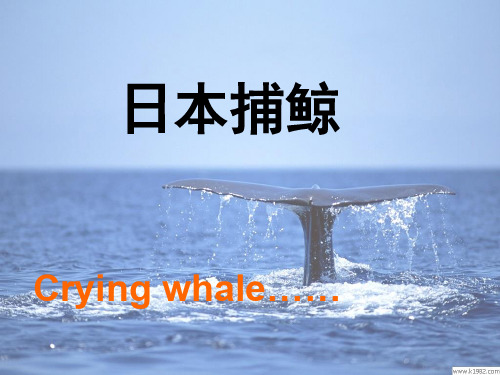
• 或许充满负罪感 • 出于谋生不得已而为之
从鲸类的立场来看…
•
日本和歌山县太极町, 是一个景色优美的小渔 村,然而这里却常年上 演着惨无人道的一幕。 每年,数以万计的海豚 经过这片海域,他们的 旅程却在太极町戛然而 止。渔民们将海豚驱赶 到靠近岸边的一个地方, 来自世界各地的海豚训 练师挑选合适的对象, 剩下的大批海豚则被渔 民毫无理由地赶尽杀 绝……
• 鲸是海洋留给我们的最后一个符号 • 发出你的声音,让你身边更多的人了解到 捕鲸的真相 • 帮助鲸的未来 ……
Thank U !
日本为何冒天下之大不韪?
一、日本具有捕鲸文化
• 日本是海洋国家,捕鲸可追溯到绳纹时代、弥生 时代(距今大约6000 年到2000 年 ) • 捕鲸浮世绘;鲸之歌… • 当食鲸文化遭到批评——反抗心态
• 商业捕鲸≠捕鲸文化
二、重要的食物
• 高蛋白的来源
二战后,日本食物匮乏,以鲸肉作为食物
• 日本人认为鲸肉是强身健体的美食
1986年国际捕鲸委员会iwc颁布全球禁止捕鲸公约禁止商业捕鲸但由于协议中存在漏洞未对科研捕鲸进行限制日本是海洋国家捕鲸可追溯到绳纹时代弥生时代距今大约6000年到2000商业捕鲸捕鲸文化二重要的食物高蛋白的来源二战后日本食物匮乏以鲸肉作为食物日本人认为鲸肉是强身健体的美食三政治因素1
日本捕鲸
Crying whale……
人类捕鲸历史悠久
——长达2000年 • 最初捕鲸方式:将系有绳索的鱼叉等工具, 射击或投掷刺入鲸体
人类与自然生物的较量——体现勇气
C.F.
工业时代后,蒸汽船以及爆破捕鲸叉的发明 ——杀戮
• 1986年国际捕鲸委员会(I.W.C)颁布《全 球禁止捕鲸公约》禁止商业捕鲸 • 但由于协议中存在漏洞,未对科研捕鲸进 行限制 • 日本捕鲸船开始以科学考察的名义重新起 航
日本坚持血腥捕鲸为几何?
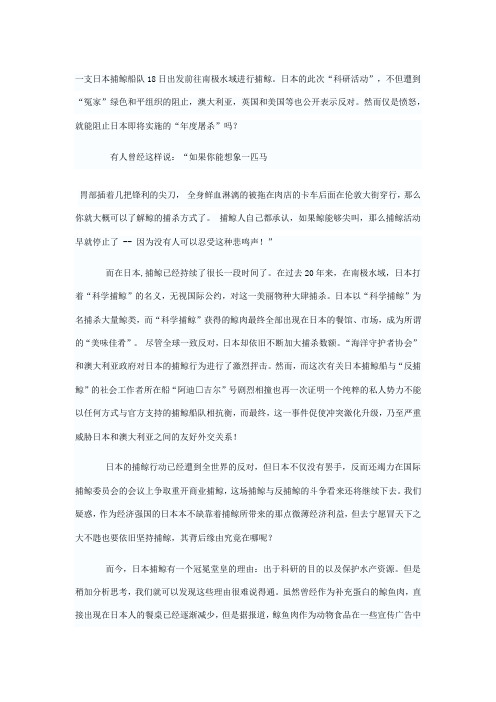
一支日本捕鲸船队18日出发前往南极水域进行捕鲸。
日本的此次“科研活动”,不但遭到“冤家”绿色和平组织的阻止,澳大利亚,英国和美国等也公开表示反对。
然而仅是愤怒,就能阻止日本即将实施的“年度屠杀”吗?有人曾经这样说:“如果你能想象一匹马胃部插着几把锋利的尖刀,全身鲜血淋漓的被拖在肉店的卡车后面在伦敦大街穿行,那么你就大概可以了解鲸的捕杀方式了。
捕鲸人自己都承认,如果鲸能够尖叫,那么捕鲸活动早就停止了 -- 因为没有人可以忍受这种悲鸣声!”而在日本,捕鲸已经持续了很长一段时间了。
在过去20年来,在南极水域,日本打着“科学捕鲸”的名义,无视国际公约,对这一美丽物种大肆捕杀。
日本以“科学捕鲸”为名捕杀大量鲸类,而“科学捕鲸”获得的鲸肉最终全部出现在日本的餐馆、市场,成为所谓的“美味佳肴”。
尽管全球一致反对,日本却依旧不断加大捕杀数额。
“海洋守护者协会”和澳大利亚政府对日本的捕鲸行为进行了激烈抨击。
然而,而这次有关日本捕鲸船与“反捕鲸”的社会工作者所在船“阿迪□吉尔”号剧烈相撞也再一次证明一个纯粹的私人势力不能以任何方式与官方支持的捕鲸船队相抗衡,而最终,这一事件促使冲突激化升级,乃至严重威胁日本和澳大利亚之间的友好外交关系!日本的捕鲸行动已经遭到全世界的反对,但日本不仅没有罢手,反而还竭力在国际捕鲸委员会的会议上争取重开商业捕鲸,这场捕鲸与反捕鲸的斗争看来还将继续下去。
我们疑惑,作为经济强国的日本本不缺靠着捕鲸所带来的那点微薄经济利益,但去宁愿冒天下之大不韪也要依旧坚持捕鲸,其背后缘由究竟在哪呢?而今,日本捕鲸有一个冠冕堂皇的理由:出于科研的目的以及保护水产资源。
但是稍加分析思考,我们就可以发现这些理由很难说得通。
虽然曾经作为补充蛋白的鲸鱼肉,直接出现在日本人的餐桌已经逐渐减少,但是据报道,鲸鱼肉作为动物食品在一些宣传广告中却仍然可以看到。
况且这种血腥的野蛮的捕鲸方式的确也不符合科研伦理的一些基本原则,真正的科学行为完全可以通过非致命的手段完成!本来就是捕杀珍贵的鲸类,怎么又能反倒说是保护水产资源呢?对此,日本全国渔业协同组合联合会专务宫原邦之的说法是:世界各国都关注水产资源,并展开对水产资源的争夺战,然而,鲸类所吃的鱼是人类渔获量的5倍,为了保护水产资源,有必要适当捕鲸。
日本的鲸文化

中国政府支持日本捕鲸? 中国政府支持日本捕鲸?
投票反对日本捕鲸计划的国家包括: 投票反对日本捕鲸计划的国家包括: 阿根廷,澳大利亚, 奥地利, 比利时, 巴西,智利,捷克共和国, 阿根廷,澳大利亚, 奥地利, 比利时, 巴西,智利,捷克共和国,丹 麦, 芬兰, 法国, 德国, 匈牙利, 爱尔兰, 意大利, 卢森堡, 墨西哥, 摩纳 芬兰, 法国, 德国, 匈牙利, 爱尔兰, 意大利, 卢森堡, 墨西哥, 荷兰, 新西兰,阿曼, 巴拿马, 葡萄牙,斯洛伐克共和国,圣马力诺, 哥,荷兰, 新西兰,阿曼, 巴拿马, 葡萄牙,斯洛伐克共和国,圣马力诺,南 西班牙,瑞典, 瑞士, 英国和美国。 非, 西班牙,瑞典, 瑞士, 英国和美国。
日本的捕鲸产业规模: 日本的捕鲸产业规模:
日本在太平洋海域有捕鲸船1000余艘, 余艘, 日本在太平洋海域有捕鲸船 余艘 捕鲸渔民及相关产业工人10万 拥有6个 捕鲸渔民及相关产业工人 万,拥有 个 捕鲸基地:北海道函馆市、 捕鲸基地:北海道函馆市、和歌山县太地 山口县下关市等。 町、山口县下关市等。日本鲸类研究所的 统计数据: 年日本生产鲸肉2849吨、 统计数据:2000年日本生产鲸肉 年日本生产鲸肉 吨 鲸皮类1051吨。鲸鱼尾部的瘦肉 鲸皮类 吨 鲸鱼尾部的瘦肉6000日元 日元 约合53美元 千克 普通瘦肉2610日元 美元) 千克, (约合 美元)/千克,普通瘦肉 日元 约合20美元 千克 上等皮3300日元( 美元) 千克, 日元( (约合 美元)/千克,上等皮 日元 约合29美元 千克 美元) 千克。 约合 美元)/千克。日本捕鲸产业年批发 总额3200多万美元。 多万美元。 总额 多万美元
日本商业捕鲸活动是日本渔民在日本政府的鼓励下以“科学考察” 日本商业捕鲸活动是日本渔民在日本政府的鼓励下以“科学考察”为借 口进行的商业捕鲸活动,是世界各国唯一的商业捕鲸活动( 口进行的商业捕鲸活动,是世界各国唯一的商业捕鲸活动(1986年起世 年起世 界绝大多数国家都禁止商业捕鲸),甚至商业捕杀一些稀有鲸种, ),甚至商业捕杀一些稀有鲸种 界绝大多数国家都禁止商业捕鲸),甚至商业捕杀一些稀有鲸种,受到 各国绿色和平组织的广泛抗议。 各国绿色和平组织的广泛抗议。
日本捕鲸与杀海豚节

Crying whale……
人类捕鲸历史悠久
——长达2000年 • 最初捕鲸方式:将系有绳索的鱼叉等工具, 射击或投掷刺入鲸体
人类与自然生物的较量——体现勇气
C.F.
工业时代后,蒸汽船以及爆破捕鲸叉的发明 ——杀戮
• 1986年国际捕鲸委员会(I.W.C)颁布《全 球禁止捕鲸公约》禁止商业捕鲸 • 但由于协议中存在漏洞,未对科研捕鲸进 行限制 • 日本捕鲸船开始以科学考察的名义重新起 航
• 只是一份工作
• 或许充满负罪感 • 出于谋生不得已而为之
从鲸类的立场来看…
•
日本和歌山县太极町, 是一个景色优美的小渔 村,然而这里却常年上 演着惨无人道的一幕。 每年,数以万计的海豚 经过这片海域,他们的 旅程却在太极町戛然而 止。渔民们将海豚驱赶 到靠近岸边的一个地方, 来自世界各地的海豚训 练师挑选合适的对象, 剩下的大批海豚则被渔 民毫无理由地赶尽杀 绝……
• 鲸是海洋留给我们的最后一个符号 • 发出你的声音,让你身边更多的人了解到 捕鲸的真相 • 帮助鲸的未来 ……
杀海豚节
• 节日习俗 每年的9月中旬开始一直到次年3月,有2 万余条海豚和小鲸会被屠杀。该行为引起 西方动物保护主义者的强烈抗议。争议、 谴责、冲突、反抗,面对全球社会的反捕 鲸抵制,日本官方一直以“捕鲸食鲸为日 本国文化及饮食传统”为由,坚持着对鲸 类的残酷猎捕。
日本为何冒天下之大不韪?
Hale Waihona Puke 一、日本具有捕鲸文化• 日本是海洋国家,捕鲸可追溯到绳纹时代、弥生 时代(距今大约6000 年到2000 年 ) • 捕鲸浮世绘;鲸之歌… • 当食鲸文化遭到批评——反抗心态
• 商业捕鲸≠捕鲸文化
日本食鲸文化
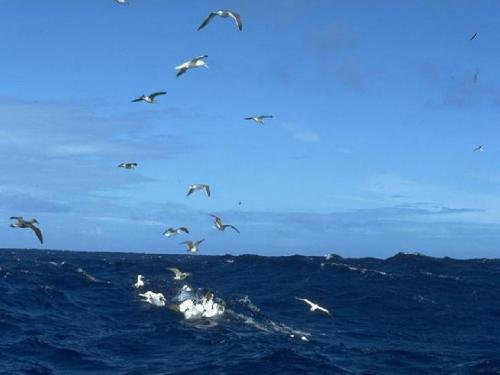
2013-3-22
•
1878(明治11)年、太地において鯨捕り111人 が捕鯨中に遭難死する大惨事が起こりま した。 その結果、網取り法はした。そして、 網取り法にかわる新しい捕鯨技術への模索が始ま りました。その模索は20年間続きました。 • 1899(明治32)年、ノルウェーから捕鯨砲を装 備した高速捕鯨船によって鯨類を捕殺す る「ノ ルウェー式捕鯨」(近代型捕鯨)を導入しました。 このノルウェー式捕鯨(近代型捕 鯨)により、 従来は捕獲不可能であったナガスクジラなどの捕 獲が可能となり、日本は新 しい捕鯨の時代入り ました。
4. まとめ
• まとめに入ります。今回の発表では、1) 日本 においては5000年以上にわたる鯨類の食 利用の 歴史があること、2) 全国各地に様々な鯨料理が あること、を明らかにしました。ま た、これら の事実から、3) 鯨類は持続的利用が可能な食料 資源であるということがわか ります。 • 今後もおいしい鯨類を食べながら、捕鯨文化、 鯨食文化について研究していきたいと 考えてい ます。 • 私たちにおいしい鯨肉を提供してくれる鯨に 感謝しながら、私の発表を終わります。ご 清聴 どうもありがとうございました。
放鲸鱼一条生路
►
これは人々が好む鯨料理の一例です。網走の 住民はミンククジラの刺身を好み、鮎川 の住民 もミンククジラの刺身を好みます。一方、和田 の住民はツチクジラのタレ(味付け 日干し肉) を好み、太地の住民はマゴンドウの刺身を好み ます。 以下、捕鯨の伝統のある町の一例として和歌 山県太地町を取り上げます。 これが「太地くじらの博物館」の写真です。 1969年に建設されました。この博物館にお いて は、鯨類の生物学のみならず、太地町における 捕鯨の歴史も学ぶことができます。
日本的捕鲸业

日本的捕鲸业【鲸遭到人类疯狂残忍的屠杀】世界上有八十多种不同的鲸鱼、海豚和齿鲸(统称鲸目动物)。
鲸目动物终身生活在海洋里。
从赤道到两极的所有海洋及五大河流里都能找到它们的身影。
作为海洋中最大的动物,鲸鱼具有无可比拟的商业价值。
鲸脂能够用来制作肥皂、蜡烛以及唇膏。
鲸须可以制成很多物品,如刷子、妇女的胸衣,还有伞骨。
捕鲸过程非常残忍,即使是使用最现代化的技术,杀死一条鲸鱼也得半个多小时。
自上个世纪初以来,商业捕鲸造成鲸类数量灾难性减少,许多鲸种已濒临灭绝。
蓝鲸是捕鲸人最喜欢的捕猎对象,但在不到100年无节制的捕猎后,99%的蓝鲸已遭捕杀。
北大西洋露脊鲸是世界上最稀有的鲸种,现在种群数量已少于300头,科学家预计将在200年内灭绝。
20世纪80年代,在南太平洋大约存在76万头鲸鱼,随着捕杀的加剧,鲸的数量锐减。
这种情况逐渐唤醒了人类的保护意识,有识之士开始采取行动减少捕猎量,保护濒危的鲸类。
国际捕鲸委员会于1982年投票通过全球终止商业捕鲸。
国际社会于1983年规定全面禁止商业捕鲸行为,1986年《禁止捕鲸公约》生效,被捕杀的鲸鱼数量从2.2万头下降到2700头。
为了保护鲸类,国际爱护动物基金会游说并协助在南极的水域建立了南部海洋保护区,使世界上百分之三十的海洋不受捕鲸业的骚扰。
【打着伪科学旗号的日本捕鲸】日本是世界捕鲸业最发达的国家之一。
日本人爱吃鲸肉,鲸肉是日本饮食的重要部分,有日本人说:“日本人摄取的动物蛋白多数来自鲸肉而不是牛肉。
”在日本历史上,鲸鱼制品是盛大宴会上和节日里的上等菜肴。
1906年日本用现代技术开始大规模捕鲸。
在日本的鲸肉料理店中,人们用刺身、油炸、火锅、蒸煮等各种烹饪方式来加工鲸肉,鲸的皮和脂肪也有特别的烹制方法。
据说,早在1300年前,日本人就开始食用鲸肉,鲸肉在日本人的饮食文化中占有很重要的位置。
日本捕鲸协会声称:“捕鲸是日本历史和文化不可分割的一部分。
”他们宣称,世界各国的人们都应该尊重日本的这种捕鲸文化。
【精品】《大国崛起·日本》第一部分(精品推荐,免费分享!!)

《大国崛起·日本》 第一部分《大国崛起》 引 子引子百年维新日本,太平洋西岸的一个岛国,与亚洲大陆隔海相望。
从17世纪初开始,这个贫弱落后的封建小国紧锁门户,渡过了两百多年闭关自守的时光。
但是,西方文明的冲击还是不可避免地到来了。
从1764年开始以后的近一百年间,西方列强频频叩关,竟达52次之多。
1853年,来自太平洋东岸美利坚合众国的四艘全副武装的黑色军舰,敲开了日本国门,日本被迫开国。
这个东方岛国遭遇了巨大的生存危机,也迎来了弃旧图新的机遇。
15年后的1868年,封建幕府被推翻,明治天皇登基。
1868年成为日本历史上具有转折意义的一年,在这一年开始了著名的明治维新。
从此,日本进行了急速的资本主义改革,在短短的几十年内成为在世界的东方崛起的强国。
50年后,日本成为当时世界大国俱乐部里唯一的一个东方国家;他的铁蹄践踏了亚洲的许多国家,他的野蛮和凶残让世界为之震惊,“大日本帝国”最终在疯狂中败亡。
1968年,明治维新100年后,日本成为世界排名第二的经济大国。
从渴望主宰自身命运到渴望成为世界的主角,在这个岛国如同海潮般激荡起落的现代化过程中,一个不曾改变的命题就是:面对西方世界,进行一场为超越而进行的最彻底的学习。
《大国崛起》 开 国(1)开国1,黑船来了日本嘉永六年,1853年7月8日。
日本江户湾(今天的东京湾)的浦贺冲。
午后,幕府检查船只的机构浦贺奉行所的执勤人员望着太阳下波光粼粼的海面,涌起一阵睡意。
突然,遥远的海面上冒出四艘黑乎乎的船影。
睁大了眼睛的执勤人员立刻紧张起来,不久这四艘船吐着滚滚浓烟快速驶来,他们立刻向周边观察的人发布指示。
就在这时,这四艘庞大的船只又从他们的视野里消失了。
当浦贺奉行所接到黑船的第一次报告的时候,黑船舰队已经在浦贺冲抛锚下碇了。
自从1720年浦贺奉行所迁移到这里,所有船只不经过检查就不能从这里通过。
这四艘巨人般漆着黑漆的黑船,堵塞在这里,让奉行所的人惊讶万分。
日本捕鲸案

REVISION OF THEPARTIAL SUBMISSION OF THE RUSSIAN FEDERATION TO THE COMMISSION ON THE LIMITS OF THE CONTINENTAL SHELF RELATED TO THE CONTINENTAL SHELF IN THE SEA OF OKHOTSKPART 1.EXECUTIVE SUMMARYEnglish Translation of the Russian Original2013Contents1. Introduction (4)2. Extended continental shelf (4)3. Provisions of Article 76 invoked in support of thesubmission (6)4. Commission members who provided advice during thepreparation of the submission (6)5. Provisions related to position of Japan in regard of9 Submission presented by the Russian Federation toCommission on the Limits of the Continental Shelf in 20016. State bodies responsible for the preparation of thesubmission (9)List of FiguresFig. 1. Extended continental shelf beyond 200 nautical miles in the area of the enclave (red) in the Sea of Okhotsk (Russian NauticalCharts, sheets 60101 and 60102)Fig. 2.3D image of the seabed of the Sea of OkhotskThe extended continental shelf in the area beyond 200 nautical miles in the areaof the enclave (chlorine area) is shown. Yellow dots show the location of thefoot of the continental slope.Fig. 3. 3D image of the seabed of the Sea of OkhotskThe extended continental shelf in the area beyond 200 nautical miles in the areaof the enclave is bounded by a red line. Yellow dots show the location of thefoot of the continental slope.1. IntroductionThe Russian Federation signed the 1982 United Nations Convention on the Law of the Sea (referred to as the Convention) on 10 December 1982 and ratified it on 26 February 1997. The Convention came into force for the Russian Federation on 11 April 1997.This submission is made pursuant to Article 76, paragraph 8 of the Convention. It is a partial submission only related to the area of the Sea of Okhotsk.This area was a part of the first submission made by the Russian Federation on 10 December 2001 in respect to all Russian extended continental shelf, which was considered by the Commission at its eleventh session held from 24 to 28 June 2002.The recommendations of the Commission adopted at that session stated in respect to the Sea of Okhotsk, that:«89. The Commission considers that in the Sea of Okhotsk, the submission needs to be supported by additional data and information. A submission in this region may require the application of the two formulae and the two constraints contained in paragraphs 4 and 5 of article 76».«163. The Commission recommends to the Russian Federation to make a well-documented partial submission in the northern part of the Sea of Okhotsk. This partial submission shall not prejudice questions relating to the delimitation of boundaries between States in the south for which a submission may be made later, notwithstanding the provisions regarding the ten year time-limit established by article 4 of Annex II to the Convention».The present partial submission was prepared with due regard to the above recommendations of the Commission.2. Extended Continental ShelfThis submission is presented with the aim to include in the extended continental shelf under Article 76 of the Convention the seabed and subsoil of a sea enclave bounded by the exclusive economic zone of the Russian Federation in the area of the Sea of Okhotsk located between 50°42′N – 55°42′N and 148°30′E – 150°44′E.It is stated in Article 3, paragraph 1 of the Federal Law «On the Exclusive Economic Zone of the Russian Federation» (№191, dated 17 December 1998) that:«The outer limit of the exclusive economic zone is established at a distance of 200 nautical miles from the baselines from which the breadth of the territorial sea is measured, if otherwise is not provided for by international agreements of the Russian Federation».Thus, the outer limit line of the exclusive economic zone of the Russian Federation in the Sea of Okhotsk is the line at a distance of 200 nautical miles from the baselines from which the breadth of the territorial sea is measured in the context of Article 76 of the Convention.The outer limit line of the exclusive economic zone of the Russian Federation in the northern Sea of Okhotsk is shown on the official charts of a scale 1:2 000 000, published by Department of Navigation and Oceanography, Russian Ministry of Defence (sheets №60101 and №60102) in accordance with Article 75, Paragraph 1 of the Convention, which states that:«Subject to this Part, the outer limit lines of the exclusive economic zone and the lines of delimitation drawn in accordance with article 74 shall be shown on charts of a scale or scales adequate for ascertaining their position. Where appropriate, lists of geographical coordinates of points, specifying the geodetic datum, may be submitted for such outer limit lines or lines of delimitation».Fig. 1. Extended continental shelf beyond 200 nautical miles in the area of theenclave (red) in the Sea of Okhotsk(Russian Nautical Charts, sheets 60101 and 60102) Therefore, the line of outer limit of the exclusive economic zone of the Russian Federation shown on the above mentioned official charts is an official legitimate line at a distance of 200 nautical miles from the baselines from which the breadth of the territorial sea is measured. The seabed and subsoil of the enclave beyond this line is a part of the natural prolongation of the Russian land territory and it is an extended continental shelf of the Russian Federation in accordance with the provisions of paragraphs 3 and 4 of Article 76.This enclave is located within the geomorphological and geological continental shelf with irregular seabed topography, which has been reworked and eroded as a result of tectonic processes. It is entirely situated landward of the foot of the continental slope, which can be clearly determined on the basis of morphological and bathymetric evidence.The foot of the slope is located to the south of the enclave in the southern Sea of Okhotsk and it can be continuously traced at water depths of 2500-3000 m from the northern part of Hokkaido Island through the southern part of Sakhalin Island and eastward along the northern edge of the Kuril (South Okhotsk) Basin towards Kamchatka Peninsula.Geological and geophysical data provide additional evidence for the location of the parts of the continental margin under paragraph 3 of Article 76 and support locating the base of the foot of the slope in that area.The enclave under consideration is entirely situated landward of the 2 500 m isobath and it is located within 350 NM limit from the baselines from which the breadth of the territorial sea is measured.Thus, the entire area of the seabed and subsoil of the said enclave beyond 200 NM zone is a part of the extended continental shelf in accordance with Article 76. Since the enclave is entirely situated landward of the base of the foot of the continental slope, no outer limits of the extended continental shelf are proposed and, in accordance with Article 76, no list of relevant coordinates is required.3. Provisions of Article 76 invoked in support of the submissionIn support of the submission the following provisions of Article 76 were invoked:✓Paragraph 1 – with regard to concept of the continental shelf being a natural prolongation of land territory to the outer edge of the continental margin beyond 200 NM zone;✓Paragraph 3 – in relation to the components of the continental margin;✓Paragraph 4 – partially, only in respect to the criteria to define the foot of the continental slope according to paragraph 4(b) of Article 76 on the basis of morphologic andbathymetric evidence.4. Commission members who provided advice during the preparation of the submissionDuring preparation of the submission the assistance was provided by the member of the Commission Dr. Ivan F. Glumov. No advice was provided by any other member of the Commission.F i g . 2. 3D i m a g e o f t h e s e a b e d o f t h e S e a o f O k h o t s kT h e e x t e n d e d c o n t i n e n t a l s h e l f i n t h e a r e a b e y o n d 200 n a u t i c a l m i l e s i n t h e a r e a o f t h e e n c l a v e (c h l o r i n e a r e a ) i s s h o w n . Y e l l o w d o t s s h o w t h e l o c a t i o n o f t h e f o o t o f t h e c o n t i n e n t a l s l o p e .F i g . 3. 3D i m a g e o f t h e s e a b e d o f t h e S e a o f O k h o t s kT h e e x t e n d e d c o n t i n e n t a l s h e l f i n t h e a r e a b e y o n d 200 n a u t i c a l m i l e s i n t h e a r e a o f t h e e n c l a v e i s b o u n d e d b y a r e d l i n e . Y e l l o w d o t s s h o w t h e l o c a t i o n o f t h e f o o t o f t h e c o n t i n e n t a l s l o p e .5. Provisions related to position of Japan in regard of Submissionpresented by the Russian Federation to Commission on the Limits of the Continental Shelf in 2001In accordance with Item 2 of Annex I (CLCS/40/Rev.1) the Russian Federation informs the Commission concerning the unresolved question of delimitation of maritime boundaries between Russia and Japan in the southern Sea of Okhotsk.The present Submission does not contain any maps on which the baselines are determined from points situated in the southern part of the Sea of Okhotsk. The enclave that constitutes the subject of the present Submission lies in the northern part of the Sea of Okhotsk and does not encumber on the part of the Sea of Okhotsk in which the territorial delimitation between the Russian Federation and Japan is not settled. The nearest points of baselines used in the present Submission are 480 km away from the area awaiting delimitation of maritime boundaries between Russian Federation and Japan.Based on the aforesaid, the Russian Federation maintains that the present Submission makes no prejudice to the issues related to delimitation of marine boundaries between Japan and the Russian Federation in the southern Sea of Okhotsk.6. State bodies responsible for the preparation of the submissionThe Federal Subsoil Resources Management Agency («Rosnedra») of the Russian Ministry of Natural Resources and Ecology, and the Department of Navigation and Oceanography of the Russian Ministry of Defence are the state bodies responsible for the preparation of the submission.The text of the submission as well as all maps, figures, appendixes and databases of the submission were prepared by the All-Russian Research Institute on Geology and Mineral Resources of the World Ocean (VNIIOkeangeologia) of the Federal Subsoil Resources Management Agency.。
海豚湾与日本捕鲸之谜

《海豚湾》与日本捕鲸之谜《海豚湾》与日本捕鲸之谜作者:凌庆成捕鲸看似经济行为,实则是日本长远资源战略的一个组成部分。
海底资源、石油、渔业资源都是维系人类生存的重要资源之一,自然也是日本争夺的对象,为此日本不惜承担国际骂名。
3月7日,纪录片《海豚湾》获得了第82届奥斯卡最佳纪录片奖。
纪录片的主人公名为理查德.奥巴瑞,他于1962年因创办电视节目《海豚的故事》而扬名美国。
他也是全世界最早、最有名的海豚训练师。
2005年,奥巴瑞找到“海洋保护协会”的创办人路易.皮斯豪斯,提出共同拍摄日本太地町渔民屠杀海豚的纪录片。
长期供职于《国家地理杂志》的摄影记者路易.皮斯豪斯欣然同意,同时他们幸运地获得了亿万富翁克拉克的资助。
经过两年精心拍摄,终于在2008年完成了这部纪录片。
影片不仅记录了太地町渔民残酷虐杀海豚的情景,人们从中还可隐约感受到其背后更深层次的当地政府、警察和渔民息息相关的利益联系––––正是这股势力构成了日本捕鲸的社会基础。
影片惊心动魄、险象环生,观众哀悯悲忿,难以自抑。
剖析“捕鲸文化”日本捕鲸的历史可以追溯到千年以前。
在古代,渔民每当捕到鲸鱼时都要庆祝,预示着这一年将会有好收成。
日本的沿海大都建有“鲸冢”、“鲸墓”、“鲸神社”、“鲸鸟居”、“鲸寺”等,甚至还有供奉“鲸观音”的。
在传统艺能方面,有“鲸呗”、“鲸舞蹈”、“鲸太鼓”等。
在日本人的观念中,鲸鱼只是鱼类之一。
自古以来人们就是靠山吃山,靠海吃海,捕捞鲸鱼实不足怪。
日本是一个多山的农耕民族,牛是极为重要的劳力,平时绝不会杀牛食肉。
公元675年,天武天皇发布禁令:在4月1日到9月30日之间禁止食用牛、马、日本猴、鸡和狗,但未包括猪。
而事实上,到1868年明治维新为止,日本人基本上是不吃猪肉的。
直至今日,在新年期间,传统日本年菜中有鸡、鱼、虾等食材,却没有四条腿的动物。
我为此特别请教过鹤岗八幡宫的宫司,他告诉我,这是基于日本自古以来的信仰和习惯。
由《海豚湾》谈日本人的捕鲸文化

ANHUIWENXUE 安徽文学安徽文学2018年3期总第416期由《海豚湾》谈日本人的捕鲸文化李庆年南京信息工程大学文学院摘要:电影《海豚湾》,描述的是一个海豚训练员与同伴如何努力制止日本和歌山县一个叫太地的小渔村进行海豚大屠杀的故事。
电影在全球引起巨大反响,本文结合电影总结了日本坚持捕鲸的理由,接着分析了其理由的荒谬之处,并进一步重点挖掘出日本捕鲸文化的本质,最后围绕与捕鲸文化紧密相连的全球环保问题阐述了个人看法,旨在呼吁每一个人为世界和平与文明而作出努力。
关键词院捕鲸文化理由荒谬之处本质反思一、《海豚湾》简介荣获奥斯卡最佳纪录片奖的美国电影《海豚湾》,记录了海豚的悲惨命运,引起了全球巨大反响和共鸣。
数以万计的海豚,途经日本和歌山县太地小渔村的明媚海域,美好旅程便戛然而止,少数音色优美的被挑出来高价卖到世界各地海洋馆,剩下的则被渔民肆意滥杀、血染海湾。
这些屠杀,却因种种利益而被政府和相关组织所隐瞒。
理查德曾是一名海豚训练师,一头海豚的自杀让他深受震撼,从此致力于海豚拯救,冒着生命危险带领团队潜入太地,只为将罪行公之于众……二、日本人坚持捕鲸文化的理由日本人喜欢捕鲸,世所共知。
可是为什么连海豚也不放过?通过电影了解到,理由大致如下:(一)捕鲸文化是日本的传统文化之一太地村村民认为,捕杀海豚在太地是维持了400年的传统,不能随便扔弃,不然渔民也没得活。
(二)没有违反国际条约和国际组织的规制20世纪以来,不少国际条约对捕鲸活动作出了规制,但对于捕杀海豚尚没有类似的规制,这也正是日本一个小渔村敢于冒天下之大不韪的原因。
(三)捕杀海豚能减少渔业损失太地渔民认为海豚是吃鱼的“害鱼”,捕鱼产量逐年降低同海豚息息相关。
(四)海豚没有濒临灭绝太地渔民称对海豚的捕杀很有分寸,捕杀量在政府的限定范围内,不可能会让鲸鱼、海豚灭绝。
(五)吃海豚跟吃其他的动物没有区别面对质问,日本官方代表反驳:“为什么海豚被如此特别看待?”言下之意,美国人吃牛肉,我们为何就不能吃海豚肉?这个问题很难回答,也就成为了他们大肆捕杀海豚的原因之一。
日本南极偷猎鲸鱼 日本人对鲸鱼有特殊的情结
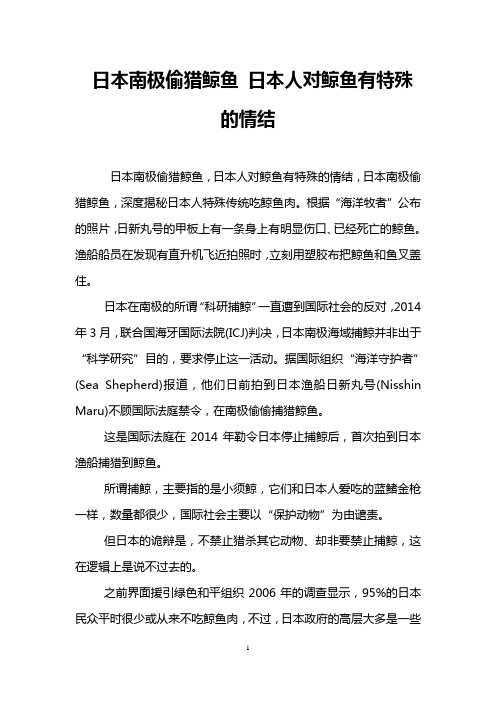
日本南极偷猎鲸鱼日本人对鲸鱼有特殊的情结日本南极偷猎鲸鱼,日本人对鲸鱼有特殊的情结,日本南极偷猎鲸鱼,深度揭秘日本人特殊传统吃鲸鱼肉。
根据“海洋牧者”公布的照片,日新丸号的甲板上有一条身上有明显伤口、已经死亡的鲸鱼。
渔船船员在发现有直升机飞近拍照时,立刻用塑胶布把鲸鱼和鱼叉盖住。
日本在南极的所谓“科研捕鲸”一直遭到国际社会的反对,2014年3月,联合国海牙国际法院(ICJ)判决,日本南极海域捕鲸并非出于“科学研究”目的,要求停止这一活动。
据国际组织“海洋守护者”(Sea Shepherd)报道,他们日前拍到日本渔船日新丸号(Nisshin Maru)不顾国际法庭禁令,在南极偷偷捕猎鲸鱼。
这是国际法庭在2014年勒令日本停止捕鲸后,首次拍到日本渔船捕猎到鲸鱼。
所谓捕鲸,主要指的是小须鲸,它们和日本人爱吃的蓝鳍金枪一样,数量都很少,国际社会主要以“保护动物”为由谴责。
但日本的诡辩是,不禁止猎杀其它动物、却非要禁止捕鲸,这在逻辑上是说不过去的。
之前界面援引绿色和平组织2006年的调查显示,95%的日本民众平时很少或从来不吃鲸鱼肉,不过,日本政府的高层大多是一些年长的男性,他们都是吃着鲸鱼肉长大的。
捕食鲸鱼由来已久日本的鱼食文化可以说是岛国的地理特性以及历史选择的必然结果。
据文字记载自从天武天皇(673~686)颁布肉食禁令以来,直到明治时期解禁牛肉为止,千余年来,日本民族一直靠鱼虾过活至今的。
而作为海洋中最大的鱼类---鲸,以其高蛋白低卡路里的美味自然也躲不过岛国人民的捕捉。
在形成有组织的捕鲸产业之前,日本早就开始食用鲸鱼肉。
据悉,在出土的旧石器时代“贝塚”(人类丢弃的贝类鱼类食物残渣)中、以及弥生时代的遗迹中就曾发现小型齿鲸的化石。
虽然在历史上,日本数次由于宗教原因禁止“食肉”,但是鲸鱼作为鱼类一直位于可食用之列。
在《古事记》中就曾记载“公元712年向神武天皇供奉鲸肉”。
位于和歌山县的太地町被视为日本捕鲸产业的发祥地。
残忍的日本捕鲸业:不顾联合国谴责,半个世纪捕杀上百万头
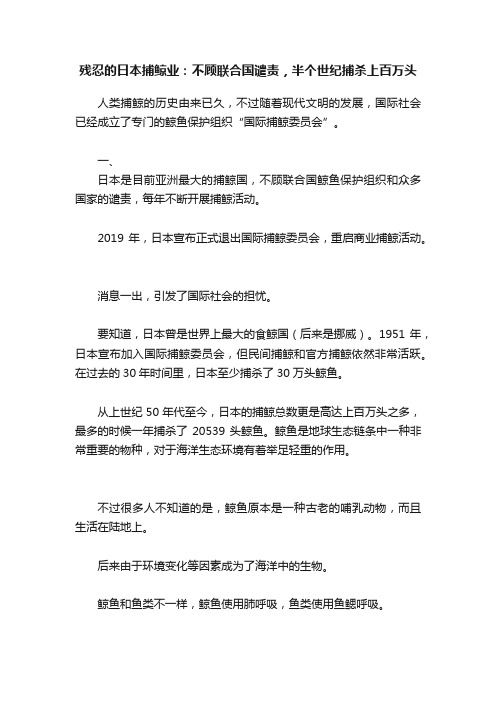
残忍的日本捕鲸业:不顾联合国谴责,半个世纪捕杀上百万头人类捕鲸的历史由来已久,不过随着现代文明的发展,国际社会已经成立了专门的鲸鱼保护组织“国际捕鲸委员会”。
一、日本是目前亚洲最大的捕鲸国,不顾联合国鲸鱼保护组织和众多国家的谴责,每年不断开展捕鲸活动。
2019年,日本宣布正式退出国际捕鲸委员会,重启商业捕鲸活动。
消息一出,引发了国际社会的担忧。
要知道,日本曾是世界上最大的食鲸国(后来是挪威)。
1951年,日本宣布加入国际捕鲸委员会,但民间捕鲸和官方捕鲸依然非常活跃。
在过去的30年时间里,日本至少捕杀了30万头鲸鱼。
从上世纪50年代至今,日本的捕鲸总数更是高达上百万头之多,最多的时候一年捕杀了20539头鲸鱼。
鲸鱼是地球生态链条中一种非常重要的物种,对于海洋生态环境有着举足轻重的作用。
不过很多人不知道的是,鲸鱼原本是一种古老的哺乳动物,而且生活在陆地上。
后来由于环境变化等因素成为了海洋中的生物。
鲸鱼和鱼类不一样,鲸鱼使用肺呼吸,鱼类使用鱼鳃呼吸。
此外,鲸鱼还有齿鲸和须鲸的分别。
最近两百年以来,由于人类的过度捕杀,鲸鱼的数量下降了70%以上。
我国也是“国际捕鲸委员会”的成员之一,为了保护鲸鱼在长江和沿海成立了20多个保护区。
不过反观日本方面,不但重启了官方捕鲸活动,而且对于泛滥的民间捕鲸活动也纵容不管。
二、2019年日本宣布退出“国际捕鲸委员会”的消息引发了很多国家担忧,因为日本曾是亚洲最大的捕鲸国。
一旦放任日本捕鲸的行为不管,将会对全世界的鲸鱼产生巨大的威胁。
日本的捕鲸历史由来已久,不仅有官方的捕鲸船队,就连民间的捕鲸活动也十分常见。
在上世纪30年代末,日本派出6艘远洋捕鲸船赶赴南极捕鲸,仅一年时间里就捕杀了2665头蓝鲸、3844头长须鲸、883头座头鲸、647头抹香鲸,创下了世界捕鲸业的记录。
第二次世界大战结束后,日本政府以“改善国民食品供应”为借口,大力鼓励民间开展捕鲸活动。
日本的船队除了在日本海附近捕鲸以外,还经常奔赴北极或者南极地区捕鲸。
日语捕鲸的两面性大纲
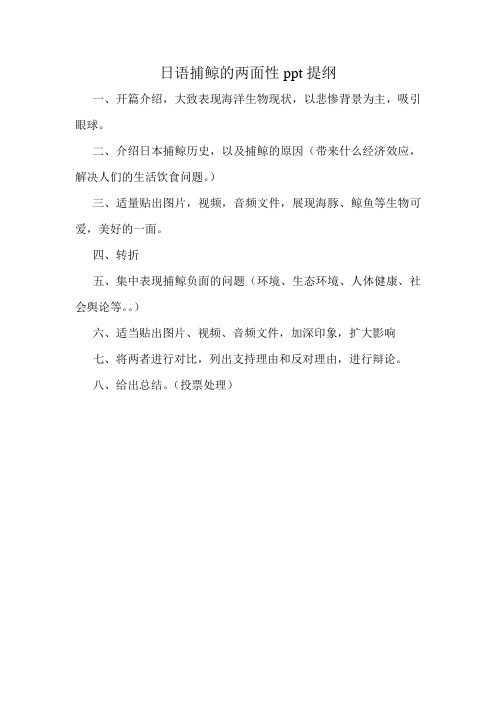
日语捕鲸的两面性ppt提纲
一、开篇介绍,大致表现海洋生物现状,以悲惨背景为主,吸引眼球。
二、介绍日本捕鲸历史,以及捕鲸的原因(带来什么经济效应,解决人们的生活饮食问题。
)
三、适量贴出图片,视频,音频文件,展现海豚、鲸鱼等生物可爱,美好的一面。
四、转折
五、集中表现捕鲸负面的问题(环境、生态环境、人体健康、社会舆论等。
)
六、适当贴出图片、视频、音频文件,加深印象,扩大影响
七、将两者进行对比,列出支持理由和反对理由,进行辩论。
八、给出总结。
(投票处理)。
日本人为何爱吃鲸肉
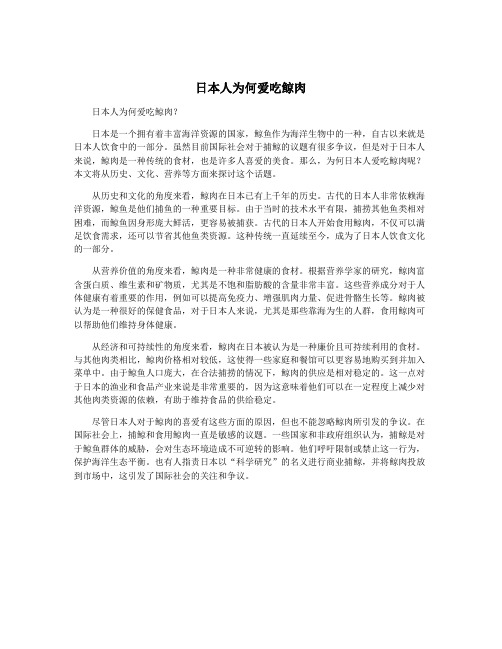
日本人为何爱吃鲸肉日本人为何爱吃鲸肉?日本是一个拥有着丰富海洋资源的国家,鲸鱼作为海洋生物中的一种,自古以来就是日本人饮食中的一部分。
虽然目前国际社会对于捕鲸的议题有很多争议,但是对于日本人来说,鲸肉是一种传统的食材,也是许多人喜爱的美食。
那么,为何日本人爱吃鲸肉呢?本文将从历史、文化、营养等方面来探讨这个话题。
从历史和文化的角度来看,鲸肉在日本已有上千年的历史。
古代的日本人非常依赖海洋资源,鲸鱼是他们捕鱼的一种重要目标。
由于当时的技术水平有限,捕捞其他鱼类相对困难,而鲸鱼因身形庞大鲜活,更容易被捕获。
古代的日本人开始食用鲸肉,不仅可以满足饮食需求,还可以节省其他鱼类资源。
这种传统一直延续至今,成为了日本人饮食文化的一部分。
从营养价值的角度来看,鲸肉是一种非常健康的食材。
根据营养学家的研究,鲸肉富含蛋白质、维生素和矿物质,尤其是不饱和脂肪酸的含量非常丰富。
这些营养成分对于人体健康有着重要的作用,例如可以提高免疫力、增强肌肉力量、促进骨骼生长等。
鲸肉被认为是一种很好的保健食品,对于日本人来说,尤其是那些靠海为生的人群,食用鲸肉可以帮助他们维持身体健康。
从经济和可持续性的角度来看,鲸肉在日本被认为是一种廉价且可持续利用的食材。
与其他肉类相比,鲸肉价格相对较低,这使得一些家庭和餐馆可以更容易地购买到并加入菜单中。
由于鲸鱼人口庞大,在合法捕捞的情况下,鲸肉的供应是相对稳定的。
这一点对于日本的渔业和食品产业来说是非常重要的,因为这意味着他们可以在一定程度上减少对其他肉类资源的依赖,有助于维持食品的供给稳定。
尽管日本人对于鲸肉的喜爱有这些方面的原因,但也不能忽略鲸肉所引发的争议。
在国际社会上,捕鲸和食用鲸肉一直是敏感的议题。
一些国家和非政府组织认为,捕鲸是对于鲸鱼群体的威胁,会对生态环境造成不可逆转的影响。
他们呼吁限制或禁止这一行为,保护海洋生态平衡。
也有人指责日本以“科学研究”的名义进行商业捕鲸,并将鲸肉投放到市场中,这引发了国际社会的关注和争议。
日本捕鲸事件

日本捕鲸事件自国际捕鲸委员会1983年规定全面禁止商业捕鲸行为以来,中国与美、英、法、德、澳等大多数国家始终反对捕鲸。
但由于《国际管制捕鲸公约》的第8条规定,任何国家能够依照科学目的击杀或者捕捞鲸,并应充分利用鲸的身体各部分,这给日本等国提供了捕鲸的合法理由。
除了施加外交压力,国际社会并没有强硬的措施能阻止日本单方面增加所谓“科研”捕鲸数量。
2005年11月8日,日本大型捕鲸船队从山口县下关港动身前往南极捕鲸,计划在今年第一季度捕杀935头小须鲸,并宣称这一捕捞计划是以科学研究为目的的。
据澳大利亚《时代报》报道,在日本,鲸肉汉堡是类似麦当劳牛肉汉堡一样,能够在大街小巷的快餐店轻易买到的。
在东京,许多的超级市场也能够买到生的鲸肉。
超市里出售的生鲸肉一般被包装起来,能够用来做寿司。
在东京以外的杂货店里,能够买到大一些的用于炖煮的鲸肉,也能够买到鲸肉制作的“培根”。
这些鲸肉来自于不同的来源:可能是那些在冰岛或者挪威被捕杀然后冷冻运回日本的鲸,也可能被捕杀于目前争议最严峻的南半球海域。
10多年来,由于国际社会禁止商业捕鲸,日本国内的鲸肉供应量大幅减少,鲸肉价格不断飞涨。
一公斤鲸肉在日本能够卖到90美元至100美元。
充足的市场需求和高昂的价格也使日本渔民捕鲸的欲望更加强烈。
2006年1月8日早晨,抗议捕鲸的绿色和平组织船只“极地曙光号”遭到了日本渔业署一艘捕鲸船的撞击。
绿色和平组织此次远征负责人谢恩·罗顿贝利说:“这只可能是一次有意的撞击。
”撞击之后,该日本捕鲸船马上开始离开。
撞击地点位于澳大利亚南极海域内35海里,属于联合国世界自然宪章规定的禁止捕鲸的南极鲸保护区。
日本的捕鲸活动,多数是在南半球公海上进行的,这是全世界共有的资源,需要各国共同致力保护。
据《澳大利亚人》报道,目前反对日本捕鲸活动的国家有巴西、阿根廷、澳大利亚、奥地利、比利时、新西兰、芬兰、法国、德国、爱尔兰、意大利、卢森堡、墨西哥、葡萄牙、西班牙、瑞士和英国。
日本捕鲸“文化”的现象与本质

日本捕鲸“文化”的现象与本质内容提要:日本捕鲸属于历史传统“文化”,但大规模捕鲸不是历史传统,二者不能混为一谈。
不能因为是“文化”就可以一味地保护,糟粕性的文化该剔除者不可手软。
人类为了食肉而宰杀动物有残酷性的一面,而日本的捕鲸的确比较残酷。
国际组织对于保护海豚工作不力和日本等国的外交活动有关。
人类只有处理好与其他生物、大自然的关系,使人与自然和谐,人类才能维系可持续发展,拥有美好的未来。
关键词:捕鲸文化太地町海豚生态保护作者简介:周喧明,外交学院国际关系研究所教授。
中图分类号:J905文献标识码:A文章编号:1002-7874(2011)02-0126-14美国西部时间2010年3月7日,以日本和歌山县太地町渔民大规模残酷捕杀海豚为内容的纪录片《海豚湾》,获得第82届奥斯卡最佳纪录长片金像奖。
该片由路易?皮斯豪斯(Louie Psilloyos)任导演、理查德?奥巴瑞(Ric O'Berry)为主人公。
摄制组从2005年开始,冒着日本和太地町方面的重重阻拦,以军事、谍报等多种手段深入太地町捕杀海豚的现场,获取了大量第一手资料。
该片拍摄历时三年多,真实地记录了日本方面不愿意让外界了解的捕杀海豚的秘密,让太地町残酷、大规模捕杀海豚的真相大白于天下。
该纪录片的放映,使日本遭受国际社会和舆论的一致挞伐。
而日本方面则辩解称捕杀鲸鱼、海豚等属于日本的历史传统和文化,日本捕杀海豚的方式和西方杀牛宰羊并无特殊区别。
每年9月开始到次年3月期间都是太地町捕鲸的旺季。
国际上的揭露和批判显得苍白无力,奥斯卡金像奖的话题随着时间的推移也被人们逐渐淡忘,然而,日本的捕鲸活动却没有停止,并且还将继续。
到底应该如何看待这些问题?这是本文想要重点探讨的地方。
一日本捕杀鲸鱼现象的文化属性客观地讲,捕鲸文化也包括捕杀小型鲸鱼――海豚,是日本地方渔业文化的一部分。
广义的文化,按照《辞海》的解释,是“人类在社会实践过程中所获得的物质、精神的生产能力和创造的物质精神财富的总和”。
- 1、下载文档前请自行甄别文档内容的完整性,平台不提供额外的编辑、内容补充、找答案等附加服务。
- 2、"仅部分预览"的文档,不可在线预览部分如存在完整性等问题,可反馈申请退款(可完整预览的文档不适用该条件!)。
- 3、如文档侵犯您的权益,请联系客服反馈,我们会尽快为您处理(人工客服工作时间:9:00-18:30)。
May 16, 2009 Ulsan, Republic of Korea「日本における捕鯨と鯨食文化」“Whaling and Whale Meatin Japanese Food Culture”浜口尚(園田学園女子大学短期大学部)Hisashi Hamaguchi (Sonoda Women’s College, Japan)日本の兵庫県尼崎市にある園田学園女子大学の教員をしている浜口尚です。
本日は鯨食文化の伝統がある蔚山広域市での「国際鯨シンポジウム」にお招きいただきまして、ありがとうございます。
私は文化人類学を教えており、日本とカリブ海地域の捕鯨文化、鯨食文化を研究対象としています。
これから、「日本における捕鯨と鯨食文化」という題で発表します。
Thank you very much for inviting me to the “Internat io nal Whale Symposium” at Ulsan, the Republic of Korea. My name is Hisashi Hamaguchi.I teach cultural anthropology at Sonoda Women’s College, A magakai, Japan. I have studied the whaling cultures of Japan and Bequia, a small island in the Caribbean Sea. Today, I would like to present a brief summary of the “history of whaling in Japan and whale meat in Japanese food culture.”《発表内容Contents 》1. 日本捕鯨の歴史History of Whaling in Japan2. 日本捕鯨の現況Whaling in Contemporary Japan3. 日本の鯨食文化Whale Meat in Japanese Food Culture4. まとめConclusion本日の発表はこの画面のとおりです。
まず日本における捕鯨の歴史から始め、次に日本の捕鯨の現況を述べ、さらに日本における鯨食文化を取り上げます。
最後に今回の発表をまとめます。
My presentation is divided into three parts, as this slide shows. 1) History of whaling in Japan, 2) Whaling in contemporary Japan, and 3) Whale meat in Japanese food culture. I will then present my conclusions.1. 日本捕鯨の歴史History of Whaling in Japan・小型鯨類(イルカ類)の捕鯨:→5000年の歴史真脇遺跡の事例・Uses of Small Cetaceans:the Early Jomon period (5000 B.P.)Remains from the Mawaki site日本の捕鯨の歴史を簡単に紹介します。
鯨類は一般的には体長3, 4m以上のものが「鯨」、それ以下のものが「イルカ」と呼ばれています。
初期の鯨類の利用は、捕獲・解体などを比較的簡単に行なえる小さな鯨類、すなわちイルカ類の利用から始まったと考えられています。
石川県にある真脇遺跡から大量のイルカ骨(カマイルカ、マイルカ)が出土しており、その中には石槍の先が刺さった骨もあります。
これらのイルカ骨の分析から、イルカ類が少なくとも縄文時代前期(紀元前3000-4000年)には捕獲され、食料として利用されていたことがわかります。
Let us begin with a brief history of whaling in Japan. Cetaceans are generally divide into large and small based on their length. Large ones (over 3-4 meters) are call ed “whales”, and sma ll ones (less than 3-4 meters) are called“dolph i ns/porpoises.” Compared with whales, it is easy to catchdolphins/porpoises. So we think the dolphin/porpoise hunting was developed first.A lot of dolphin bones (e.g. Pacific white-sided dolphins, short-beaked common dolphins) and stone spear points were found at the Mawaki site, Ishikawa Prefecture. This shows that the dolphin hunting was conducted in the Early Jomon period (4000-3000 B.C.). So we have a history of dolphin hunting for over 5000 years.・大型鯨類の捕鯨:「寄り鯨」(座礁鯨、漂着鯨)の利用からセミクジラ、コククジラの捕獲へ・Uses of Large Cetaceans:Stranded Whales (passive)↓Active Whalingex. Right Whale, Gray Whaleでは、ではイルカのような小型鯨類ではなく大型鯨類の利用はどのようにして始まったのでしょうか?大型鯨類の利用は「寄り鯨」(座礁鯨、漂着鯨)の利用から始まったと考えられています。
寄り鯨の利用には高度な捕獲技術を必要としないからです。
寄り鯨の利用から大量の肉と脂を供給する鯨のもつ魅力を知った人々は、次の段階では積極的に捕鯨に出かけるようになります。
なぜならば、待つだけでは次の寄り鯨の機会がいつになるかわからないからです。
かつて日本近海はセミクジラやコククジラなどの回遊路にあたっており、これらの鯨は泳ぐのが遅く、手漕ぎの小舟で簡単に追いつくことができ、捕獲するのが比較的容易な鯨類でした。
当然、これらの鯨が積極的な捕鯨の対象となりました。
How about whaling of the large cetaceans? We think people used stranded whales at first. It was easy to use the stranded whales, and was not necessary to have the elaborated skills associated with hunting. Those who had known a large quantity of meat and blubber from a stranded whale started active whaling as the next step. This was because there was no guarantee of another stranded whale. The large cetaceans, such as right whales and gray whales, used to migrate in the neighboring waters of Japan. It was easy to catch them because they swam slowly. That is why people went out to hunt these whales.・1570年代(in the 1570s)「突き捕り法」Whaling with Hand-harpoons↓・1675年(in 1675)「網取り法」Whaling with Nets↓[200年][200 years]1570年代に(現在の愛知県)伊勢湾一帯において、手投げ銛を用いて鯨類を突き捕る「突き捕り法」と呼ばれる捕鯨法が始まりました。
この突き捕り法は一定の成果をもたらしました。
しかしながら、追跡している鯨に逃げられたり、銛を打ち込んだにもかかわらず、鯨が海中に没してしまうなど、捕獲効率はあまりよくありませんでした。
捕獲効率改善ための試行錯誤の後、1675年に(現在の和歌山県)太地において海中に入れた網の中に鯨類を追い込み、銛で捕殺する「網取り法」が創出されました。
この網取り法によって、捕獲効率は随分高まりました。
この網取り法はその後200年間用いられました。
In the 1570s, a whaling method call ed “Tsuk itori-hou” (whaling with hand- harpoons) began in the Ise Bay. Although this method gave whalers a certain degree of success, it was too inefficient due to the struck-and-lost rates.After much trial and error, whalers invented a new whaling method called “Amitori-hou” (whaling with nets) in Taiji in 1675. This new method increased catching efficiency considerably and decreased the struck-and-lost rates. The “Amitor i-hou” had been used for 200 years.・1878(明治11)年(in 1878)網取り法の終焉the End of Whaling with Nets↓[新技術の模索、20年]↓[Toward a New Whaling Technology]・1899(明治32)年(in 1899) ノルウェー式(近代型)捕鯨導入Introduction of theNorwegian Whaling A New Era1878(明治11)年、太地において鯨捕り111人が捕鯨中に遭難死する大惨事が起こりました。
